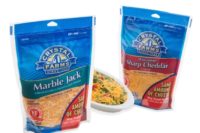Dairy foods aren’t naturally great sources of fiber, but many fiber ingredients are added to dairy foods. The new Nutrition Facts regulations have redefined fiber, increasing the Daily Value from 25 to 28 grams, and making the calculation of fiber content on the food label more complicated.
These regulations will require increased recordkeeping for dairy processors that add fiber to their products. If you are one of them, you’ll need to adjust calorie content for fiber ingredients, and review existing health or nutrient content claims that are based on fiber content. You will want to follow the Food and Drug Administration’s Citizen Petition process closely and be nimble in adjusting to evolving approval status on specific fiber ingredients.
Fibers with benefits
The new definition of dietary fiber is “non-digestible soluble and insoluble carbohydrates (with 3 or more monomeric units), and lignin that are intrinsic and intact in plants” and “isolated or synthetic non-digestible carbohydrates (with 3 or more monomeric units) determined by FDA to have physiological effects that are beneficial to human health.”
The FDA determined that these seven fibers are recognized as having health benefits:
- Beta-Glucan
- Cellulose
- Guar Gum
- Locust Bean Gum
- Pectin
- Hydroxypropylmethylcellulose
- Psyllium Husk
Suppliers of other fibers will have to submit a Citizen Petition outlining their health benefits in order to be recognized as “dietary fiber” on the new label. FDA will be issuing guidance regarding the type of scientific evidence they consider pertinent for the evaluation of beneficial physiological effects of isolated and synthetic fibers.
“A partial list of fibers not currently recognized and that would have to first go through a petition process to be declared as dietary fiber include inulin, bamboo fiber, soy fiber, pea fiber, wheat fiber, cotton seed fiber, sugar cane fiber, sugar beet fiber and oat fiber. In fact, petitions have already been submitted to include corn fiber, inulin, modified wheat starch and polydextrose,” said John Szpylka the scientific affairs director for chemistry at Mérieux NutriSciences.
Companies that want to stay abreast of newly approved beneficial fibers can check status of petitions and FDA actions at Regulations.gov or communicate with their fiber ingredient supplier.
Counting carbs. Literally
Under the old FDA label regulations, dietary fiber could be measured analytically by one of several official AOAC methods. No separate recordkeeping was required. That has changed.
“If your product contains any nondigestible carbs that are not recognized by FDA as dietary fibers, you must have records in the form of recipes, formulas or database,” Szpylka said.
Previously, total calories were calculated by subtracting four times the percent of insoluble dietary fiber. Under the new regulations, calories are calculated by subtracting four times the amount of nondigestible carbs, then adding back two times the amount of soluble nondigestible carbs. A caloric value of 1 kcal/gram has been requested for polydextrose.
Fiber’s function in dairy foods
So why bother to add fiber to dairy? The answer lies in its unique functionality. Inulin or chicory root fiber is used in fluid milk, ice cream, yogurt and drinkable yogurts.
“Beyond its health benefits, chicory root fiber provides a number of functional properties,” said Carol Lowry, a Cargill senior food scientist. “It serves as a fat mimetic, mimicking the texture of fat, giving added richness and improved mouth feel to lower-fat foods with fewer calories. It acts as a bulking agent, replacing the bulk left from sugar reduction. In addition, it’s a flavor modulator, making it an excellent partner for high-intensity sweeteners and polyols in reduced-sugar applications.”
Polydextrose helps to reduce ice crystal formation and maintain textural integrity in ice cream, and to optimize organoleptic properties in yogurts and dairy drinks.
“Our polydextrose helps to reduce calories in formulations by rebalancing bulk, viscosity and mouthfeel in reduced-sugar/reduced-fat products. In addition, its high solubility enables manufacturers to significantly boost fiber without creating a chalky or grainy texture,” said Jim Carr, the director of applications at Tate & Lyle.
The new fiber regulations leave many companies in a quandary. How long will it take the FDA to respond to the various citizen petitions? Should they wait or reformulate? Most suppliers are optimistic.
“Every manufacturer has to make their own decision on how to proceed, but we are confident that our full portfolio of solutions will meet FDA requirements and continue to provide manufacturers with options to meet their specific product needs and consumer demand,” said Nancy Gaul, the senior category marketing manager of health & wellness at Tate & Lyle.



